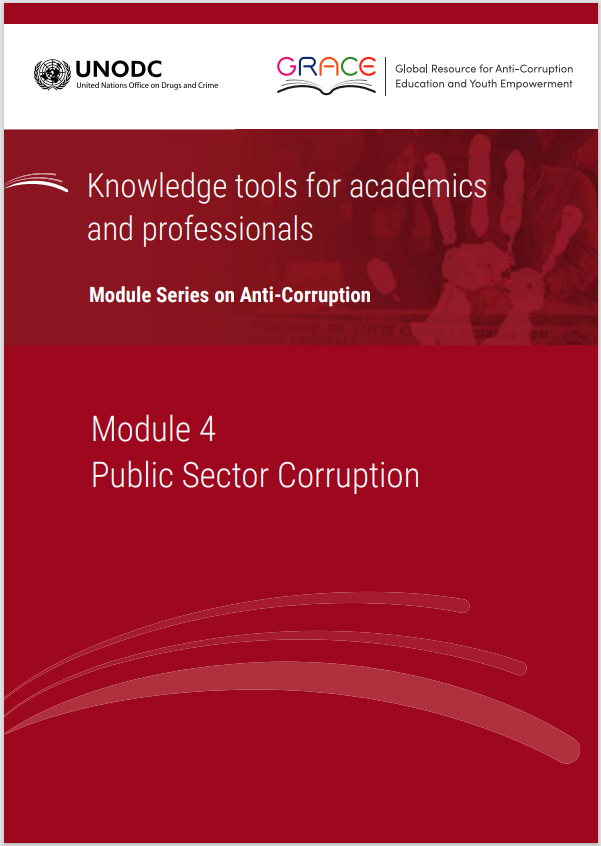This module is a resource for lecturers
Key issues
Corruption is a complex phenomenon, without a uniform definition. An overview of the different forms and definitions of corruption, as well as its harmful effects across the globe, is available in Module 1 of the E4J University Module Series on Anti-Corruption. For present purposes, it should be noted that the United Nations Convention against Corruption (UNCAC) refrains from providing one overarching definition of "corruption". Rather, it defines and classifies various acts of corruption as criminal offences, such as bribery and embezzlement (in both the public and private sectors); abuse of functions (i.e. when those performing public functions misuse their power to obtain a benefit); trading in influence; illicit enrichment; and money laundering. With 186 States parties (as of December 2019), UNCAC is approaching universal adherence, and the different acts of corruption as defined by the Convention can be considered internationally accepted.
This Module focuses on corruption in the public sector. In particular, it discusses the various acts and manifestations of corruption in the public sector, its causes and consequences, theoretical explanations, responses to corruption and prevention mechanisms. The areas of public procurement and state-owned enterprises are explored in detail given their particular vulnerability to corruption. Before delving into these issues, the Module clarifies the meaning of public sector and public officials, and distinguishes between public sector corruption and private sector corruption.
Basic terms: public sector and public officials
At the outset, it is important to define certain basic terms such as public sector and public officials. The phrase "public sector" refers to organizations and institutions that exist to serve a public purpose. The public sector consists of both the branches of government and the bureaucratic structures and processes that constitute the government. The public sector provides the administrative services for the branches of government (executive, legislature and judiciary) and public services such as health, education, policing, military, infrastructure, water and transportation. The public sector further includes the oversight and accountability organizations that monitor and audit the performance of these services. Besides the public sector, this Module addresses organizations that carry out commercial activities but are owned by the government and are referred to as state-owned enterprises (SOEs) or public enterprises. Examples of SOEs include mortgage companies, and oil and gas corporations.
The persons who work in the public sector may be elected or appointed, and are usually called public officials. Some jurisdictions refer to non-elected public officials as civil servants or public servants. Article 2 of UNCAC defines a public official as:
- any person holding a legislative, executive, administrative or judicial office of a State Party, whether appointed or elected, whether permanent or temporary, whether paid or unpaid, irrespective of that person's seniority;
- any other person who performs a public function, including for a public agency or public enterprise, or provides a public service, as defined in the domestic law of the State Party and as applied in the pertinent area of law of that State Party;
- any other person defined as a "public official" in the domestic law of a State Party.
This definition of a public official is very broad and extends to those who work in SOEs for example. This broad definition is significant because many of the provisions of UNCAC impose obligations on public officials. Moreover, it sets the minimum standards of what the national legislations should cover when defining public officials. For a further discussion on the public sector and public officials, see Module 13 of the E4J University Module Series on Integrity and Ethics.
Public sector corruption versus private sector corruption
When learning about public sector corruption, it is helpful to keep in mind the differences between private sector corruption and public sector corruption. For present purposes, public sector corruption primarily abuses government resources whereas private sector corruption primarily abuses private or commercial resources. While UNCAC defines a number of differe nt corruption offences, corruption is sometimes understood in general terms as "the abuse of entrusted power for private gain", in accordance with the definition proposed by the non-governmental organization Transparency International (TI). It is clear from both the TI definition of corruption, as well as the corruption offences defined in UNCAC, that corruption occurs in both the public and private sectors. Public officials are entrusted with power to serve the public interest, whereas employees and directors in the private sector are entrusted with power to serve legitimate company interests. In both contexts, corruption occurs when individuals or organizations promote interests that differ from the interests they were entrusted to serve. Identifying what interest should be served, and who or what is being served instead, could help us distinguish between public sector corruption and private sector corruption. Private sector corruption is addressed in Module 5 of the E4J University Module Series on Anti-Corruption.
The following sections of the module provide an overview of:
- Manifestations and consequences of public sector corruption
- Causes of public sector corruption
- Theories that explain corruption
- Corruption in public procurement
- Corruption in state-owned enterprises
- Responses to public sector corruption
- Prevention of public sector corruption
 Next: Manifestations and consequences of public sector corruption
Next: Manifestations and consequences of public sector corruption
 Back to top
Back to top
